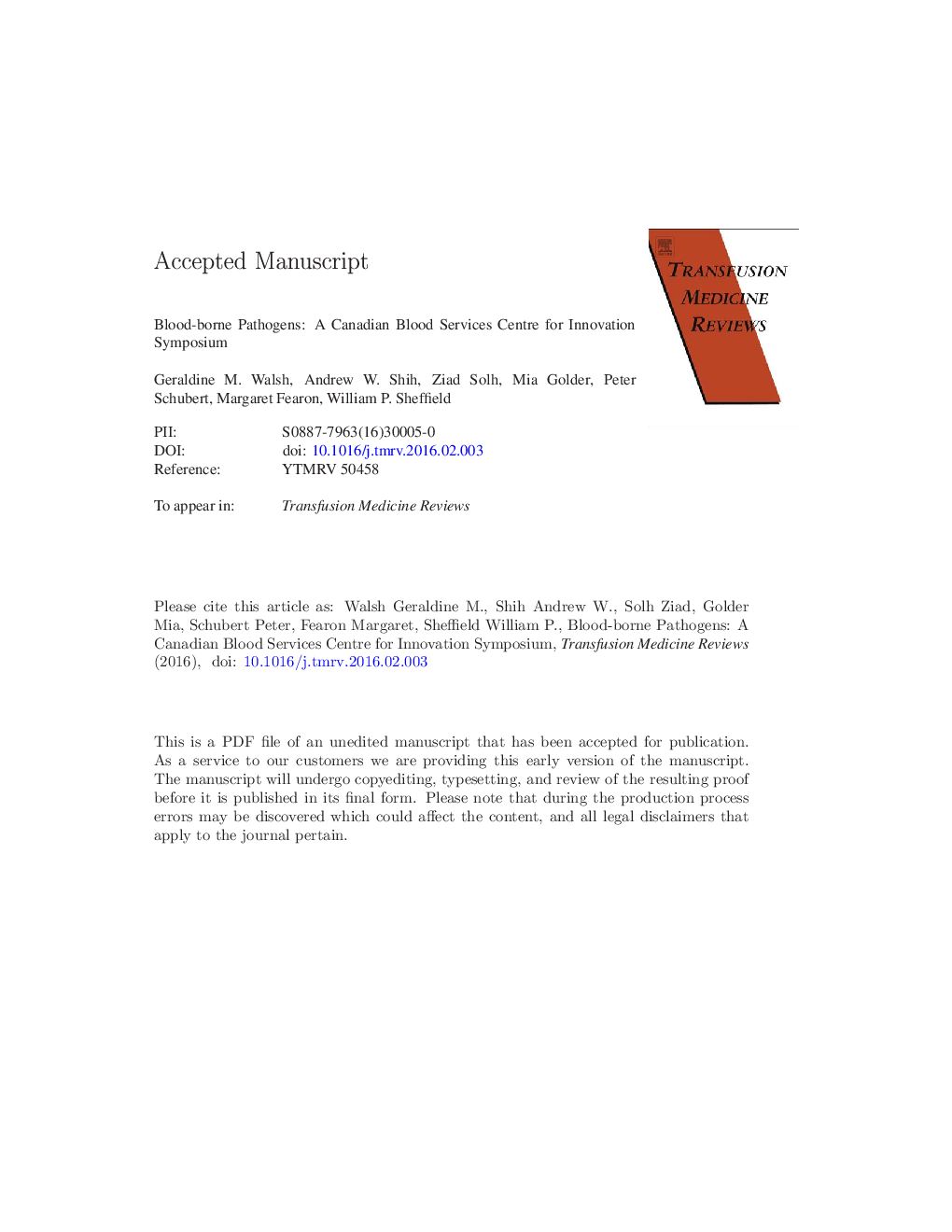| کد مقاله | کد نشریه | سال انتشار | مقاله انگلیسی | نسخه تمام متن |
|---|---|---|---|---|
| 6114325 | 1213604 | 2016 | 76 صفحه PDF | دانلود رایگان |
عنوان انگلیسی مقاله ISI
Blood-Borne Pathogens: A Canadian Blood Services Centre for Innovation Symposium
دانلود مقاله + سفارش ترجمه
دانلود مقاله ISI انگلیسی
رایگان برای ایرانیان
کلمات کلیدی
Transfusion-transmitted infectionQALYVariant Creutzfeldt-Jakob diseaseFDAvCJDhuman T-lymphotropic virusUCSFNGSRBCHBsAgWNVNATHTLVHealth economics - اقتصاد سلامتTransfusion - ترانسفوزیون یا انتقال خونnucleic acid testing - تست اسید نوکلئیکNext generation sequencing - توالی نسل بعدیPathogen inactivation - خنثی سازی پاتوژنUniversity of California San Francisco - دانشگاه کالیفرنیا سان فرانسیسکوSARS - سارسWorld Health Organization - سازمان بهداشت جهانیFood and Drug Administration - سازمان غذا و داروQuality Adjusted Life Years - سالهای زندگی سالم تنظیم شدهhematopoietic stem cells - سلول های بنیادی خونسازhematopoietic stem and progenitor cells - سلول های بنیادی و پروژسترون خونsevere acute respiratory syndrome - سندرم شدید حاد تنفسیcytomegalovirus - سیتومگالوویروسCMV - سیتومگالوویروسHBV - هپاتیت بHepatitis C virus - هپاتیت سیHCV - هپاتیت سیpolymerase chain reaction - واکنش زنجیره ای پلیمرازPCR - واکنش زنجیرهٔ پلیمرازChikungunya virus - ویروس Chikungunyahuman immunodeficiency virus - ویروس نقص ایمنی انسانیHIV - ویروس نقص ایمنی انسانی West Nile virus - ویروس نیل غربیhepatitis B virus - ویروس هپاتیت بیBlood-borne pathogens - پاتوژن های منتقل شده از خونCHIKV - چیکوWHO - کهred blood cell - گلبول قرمز، اریتروسیت
موضوعات مرتبط
علوم پزشکی و سلامت
پزشکی و دندانپزشکی
هماتولوژی
پیش نمایش صفحه اول مقاله

چکیده انگلیسی
Testing donations for pathogens and deferring selected blood donors have reduced the risk of transmission of known pathogens by transfusion to extremely low levels in most developed countries. Protecting the blood supply from emerging infectious threats remains a serious concern in the transfusion medicine community. Transfusion services can employ indirect measures such as surveillance, hemovigilance, and donor questioning (defense), protein-, or nucleic acid based direct testing (detection), or pathogen inactivation of blood products (destruction) as strategies to mitigate the risk of transmission-transmitted infection. In the North American context, emerging threats currently include dengue, chikungunya, and hepatitis E viruses, and Babesia protozoan parasites. The 2003 SARS and 2014 Ebola outbreaks illustrate the potential of epidemics unlikely to be transmitted by blood transfusion but disruptive to blood systems. Donor-free blood products such as ex vivo generated red blood cells offer a theoretical way to avoid transmission-transmitted infection risk, although biological, engineering, and manufacturing challenges must be overcome before this approach becomes practical. Similarly, next generation sequencing of all nucleic acid in a blood sample is currently possible but impractical for generalized screening. Pathogen inactivation systems are in use in different jurisdictions around the world, and are starting to gain regulatory approval in North America. Cost concerns make it likely that pathogen inactivation will be contemplated by blood operators through the lens of health economics and risk-based decision making, rather than in zero-risk paradigms previously embraced for transfusable products. Defense of the blood supply from infectious disease risk will continue to require innovative combinations of surveillance, detection, and pathogen avoidance or inactivation.
ناشر
Database: Elsevier - ScienceDirect (ساینس دایرکت)
Journal: Transfusion Medicine Reviews - Volume 30, Issue 2, April 2016, Pages 53-68
Journal: Transfusion Medicine Reviews - Volume 30, Issue 2, April 2016, Pages 53-68
نویسندگان
Geraldine M. Walsh, Andrew W. Shih, Ziad Solh, Mia Golder, Peter Schubert, Margaret Fearon, William P. Sheffield,